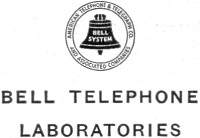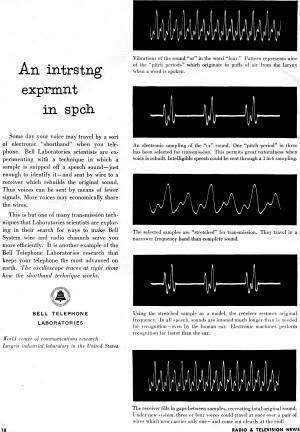|
Here is a little insight into
early speech processing research by the Bell Telephone Laboratories. 1957 was the
early era of real-time digital processing where the need to cram more calls into
less signal space (bandwidth) led to sampled systems - 1:6 in the case of this advertisement
from Bell that appeared in Radio & Television News. Engineers of the
day would be amazed at how the state of the art has advanced since then, both in
mathematical techniques and in miniaturized hardware. Waaaaay back in the early
1990s while working at Comsat Laboratories,
in Germantown, Maryland, one of the Intelsat earth station modem transceivers I
worked on used groundbreaking software algorithms to reduce call bandwidth by replacing
certain parts of spoken word sounds with shorter segments of code that would then
be reassembled at the receiver end. I specifically remember the software guys have
a hard time getting the "s" sound, "ess," working properly. That issue and many
others were conquered long ago.
An Intrstng Exprmnt in Spch

Vibrations of the sound "or" in the word "four." Pattern represents
nine of the "pitch periods" which originate in puffs of air from the larynx when
a word is spoken.

An electronic sampling of the "or" sound. One "pitch period"
in three has been selected for transmission. This permits great naturalness when
voice is rebuilt. Intelligible speech could be sent through a 1 in 6 sampling.

The selected samples are "stretched" for transmission. They travel
in a narrower frequency band than complete sound.

Using the stretched sample as a model, the receiver restores
original frequency. In all speech, sounds are intoned much longer than is needed
for recognition - even by the human ear. Electronic machines perform recognition
far faster than the ear.

The receiver fills in gaps between samples, recreating total
original sound. Under new system, three or four voices could travel at once over
a pair of wires which now carries only one - and come out clearly at the end!
Some day your voice may travel by a sort of electronic "shorthand" when you telephone.
Bell Laboratories scientists are experimenting with a technique in which a sample
is snipped off a speech sound - just enough to identify it - and sent by wire to
a receiver which rebuilds the original sound. Thus voices can be sent by means of
fewer signals. More voices may economically share the wires.
This is but one of many transmission techniques that Laboratories scientists
are exploring in their search for ways to make Bell System wire and radio channels
serve you more efficiently. It is another example of the Bell Telephone Laboratories
research that keeps your telephone the most advanced on earth. The oscilloscope
traces at right show how the shorthand technique works.

World center of communications research
Largest industrial laboratory in the United States

Original full-page Bell Telephone Laboratories advertisement
Posted April 25, 2023
(updated from original post
on 6/20/2013)
|















